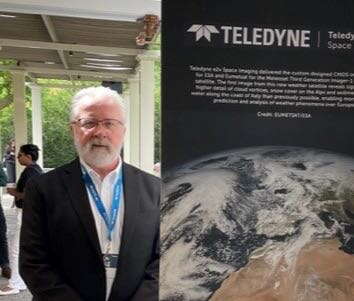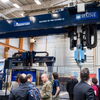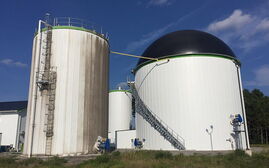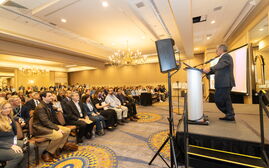
With eye on Maine’s space industry, $5.5B global tech company opens Brunswick office
 COURTESY / BLUSHIFT AEROSPACE
Global tech company Teledyne Technologies Inc. has an eye toward participating in the development of a space-related innovation hub in Maine. Seen here is a small-rocket launch by another member of Maine's space industry, also based at Brunswick Landing, bluShift Aerospace.
COURTESY / BLUSHIFT AEROSPACE
Global tech company Teledyne Technologies Inc. has an eye toward participating in the development of a space-related innovation hub in Maine. Seen here is a small-rocket launch by another member of Maine's space industry, also based at Brunswick Landing, bluShift Aerospace.
A $5.5 billion global tech company, Teledyne Technologies Inc., has opened an office at Brunswick Landing with an eye toward participating in the state's commercial space industry and the nascent Maine Space Complex.
Teledyne is attracted to the “three-legged stool” concept behind the complex, Jack Mills, head of sales and business development in the Americas for Teledyne's space imaging unit, told Mainebiz.
The complex is defined by Maine Space 2030 as being comprised of three core business units spanning several geographic locations around the state:
- A center for space data and advanced analytics
- A space innovation hub
- A small rocket spaceport launch facility.
Maine Space 2030 is a campaign launched by the Maine Space Grant Consortium to raise awareness of the economic potential of the new space economy for the Pine Tree State.
“I can’t emphasize enough that the approach the group in Maine is taking is very intelligent,” said Mills. “They’re saying, ‘Come up here and see what we’re doing.’”
Eyes on Maine
Teledyne (NYSE: TDY), headquartered in Thousand Oaks, Calif., provides digital imaging products and software, instrumentation, aerospace and defense electronics, and engineered systems. With operations primarily in the U.S., Canada, the United Kingdom, and western and northern Europe, the company has over 14,000 employees.
Examples of its space-related products include infrared detectors on the James Webb Space Telescope. The detectors are the “eyes” of the world's most advanced space telescope, allowing it to observe the universe’s first stars and galaxies.
In November, the consortium convened the first Maine Space Conference in Portland, which provided an overview of the space industry in Maine and its potential to grow.
The idea is that Maine could be an integral player in the “new space” industry by 2030 and, by 2042, the industry could be contributing up to $1.1 billion a year to the state economy, Terry Shehata, executive director of the consortium and co-founder of Maine Space 2030, has told Mainebiz.
Maine’s assets include over 85 aerospace companies already operating, advanced materials facilities, and unique geographic access for polar space orbits.
In 2022, the Maine Legislature established the Maine Space Corp. as a quasi-state body to manage the growth and development of the Maine Space Complex.
Mills’s office is co-located with the Maine Space Corp. at Brunswick Landing.
‘Maine? A spaceport?’
Mills said he became aware of these developments through a newspaper article two years ago.

“There was an article in the Boston Globe that mentioned that Maine was looking at the concept of a spaceport,” he said. “I read it and said, ‘You’ve got to be kidding me. Maine? A spaceport?’”
He added, “In the 35-plus years I’ve been doing this, it’s very rare you have an opportunity to be involved in something like this.”
He contacted Shehata for a meeting. After some discussions, Teledyne gave the go-ahead to rent a part-time office from the Maine Space Corp. at Brunswick Landing. Mills spends about one week per month there, networking with higher education, research and development, and commercial entities with a space-related presence.
The mission is to be part of the development of the innovation hub — one of the three legs of the Maine Space Complex that would bring together technology, development and organizations.
The focus of the hub is on the design and launch of small satellites and launch vehicles, with increased participation by private investors and startups in space exploration and the development of associated products and services.
It also involves recruiting more space-related businesses; building on the research-and-development and educational capabilities in the state’s institutions of higher education; and building a pipeline of students and workers.
“Maine has been providing different types of technology to the space industry for a number of years,” said Mills. “But no one hears about it because there’s been no one focus point.”
Moving forward, said Mills, Teledyne’s goal is to support development of the innovation hub for the space market both within Maine and beyond, with the potential of taking Maine-made products and services to the broader market and for bringing resources to Maine.
And Teledyne’s name could help build awareness of the state’s potential in the space industry.
“Having Teledyne’s name in Maine could potentially bring in more companies for collaborations,” said Mills.
Other states have spaceports. But Maine is the only state, said Mills, whose plans bring together ideas for a data center, an innovation hub and a spaceport.
“Maine is the only one that is that is doing this three-legged stool approach,” he said. “That’s important.”
He noted that Kodiak Island, in Alaska, has the Pacific Spaceport Complex.
“But what happens to a place like that, all that investment and technology, when there are no launches going on?” said Mills. “By having these other pieces of the puzzle, with that potential for launching added in, a company like Texas Instruments can say, ‘Maybe we should get involved with the technology side.’ That lets companies grow while the spaceport side is gaining steam. That’s what make Maine unique compared with other places in the U.S.”














0 Comments